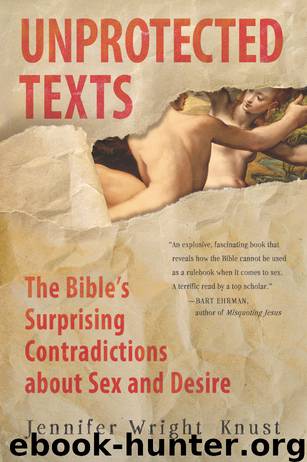Unprotected Texts by Jennifer Wright Knust

Author:Jennifer Wright Knust
Language: eng
Format: epub
Publisher: HarperCollins
Sex with Strangers
Israelites, Judeans, and Christians were not the first groups to attempt to create community boundaries by manufacturing a sex panic, and they will not be the last. From American antimiscegenation laws to rhetoric about the “racial degeneration” that occurs when the “blood” of one group is combined with another, anxieties about crumbling social divisions are regularly represented as sexual crises, especially when resources, land, and labor are at stake. So, for example, when Australia gained its independence in 1901, offspring produced by white men and Aboriginal women, once tolerated as inevitable products of colonial expansion, came to be regarded as a “half-caste menace” requiring systematic state response. Children who appeared to be less than 51 percent Aborigine were forcibly removed from reservations and sent to institutions where they would be trained in “acting white,” and then allowed to relocate among the lower echelons of white society, a policy that was abandoned only in 1967.74 In the United States, discriminatory laws sorting among whites, Native Americans, African Americans, Asian Americans, and their children served as a bulwark of white privilege for more than two centuries. Accompanied by a racist rhetoric as venomous as anything 1 Enoch could say about wicked angels or Justin Martyr about Jews, laws against intermarriage presented the white race as “civilized” even as nonwhite labor was ruthlessly exploited and nonwhite bodies were systematically disenfranchised.75 To offer just one example, in 1824 when the highly educated Cherokee John Ridge married Sarah Northrup, the genteel daughter of a Connecticut aristocrat, the local paper declared that “the girl ought to be publicly whipped, the Indian hung and the mother drowned.”76 Whether expressed as a crisis of seed or of blood, the stranger within refuses to stay strange for long. And that is precisely the problem.
The next chapter turns to biblical discussions of actual flesh—its parts, its fluids, and its functions. Sexual intercourse was, biblical writers warned, a passageway through which inappropriate mixing between different kinds of flesh could take place, threatening the viability of the nation or the community. Foreskins, semen, and menstrual blood were also employed as key symbols of difference in biblical literature. Over time, the presence or absence of a foreskin became the central sign of Israelite identity, so much so that the apostle Paul could call Jews “the circumcised” and Gentiles “the foreskinned.” The handling of semen and menstruation was also taken as a proof of the community’s special relationship to Yhwh. Keeping genital discharges away from the sanctuary marked God’s house as a sacred precinct, separate from the mundane pollutions of daily living. When the Romans destroyed the Jerusalem temple in 70 CE, concerns about contact with semen and vaginal blood were transformed, but not eliminated. Later Jews and Christians, for example, continued to wonder if menstruating women ought to visit the synagogue or the church, with some ruling that they should and others ruling that they should not. Approaches to the human body—particularly the sexed human body—could convey a great deal about what it might mean to be Israelite, Jewish, or Christian.
Download
This site does not store any files on its server. We only index and link to content provided by other sites. Please contact the content providers to delete copyright contents if any and email us, we'll remove relevant links or contents immediately.
The Lost Art of Listening by Michael P. Nichols(7408)
Why I Am Not A Calvinist by Dr. Peter S. Ruckman(4100)
The Rosicrucians by Christopher McIntosh(3466)
Wicca: a guide for the solitary practitioner by Scott Cunningham(3127)
Signature in the Cell: DNA and the Evidence for Intelligent Design by Stephen C. Meyer(3071)
Real Sex by Lauren F. Winner(2967)
The Holy Spirit by Billy Graham(2893)
To Light a Sacred Flame by Silver RavenWolf(2768)
The End of Faith by Sam Harris(2690)
The Gnostic Gospels by Pagels Elaine(2472)
Waking Up by Sam Harris(2392)
Nine Parts of Desire by Geraldine Brooks(2326)
Jesus by Paul Johnson(2310)
Devil, The by Almond Philip C(2282)
The God delusion by Richard Dawkins(2265)
Heavens on Earth by Michael Shermer(2237)
Kundalini by Gopi Krishna(2137)
Chosen by God by R. C. Sproul(2123)
The Nature of Consciousness by Rupert Spira(2047)
